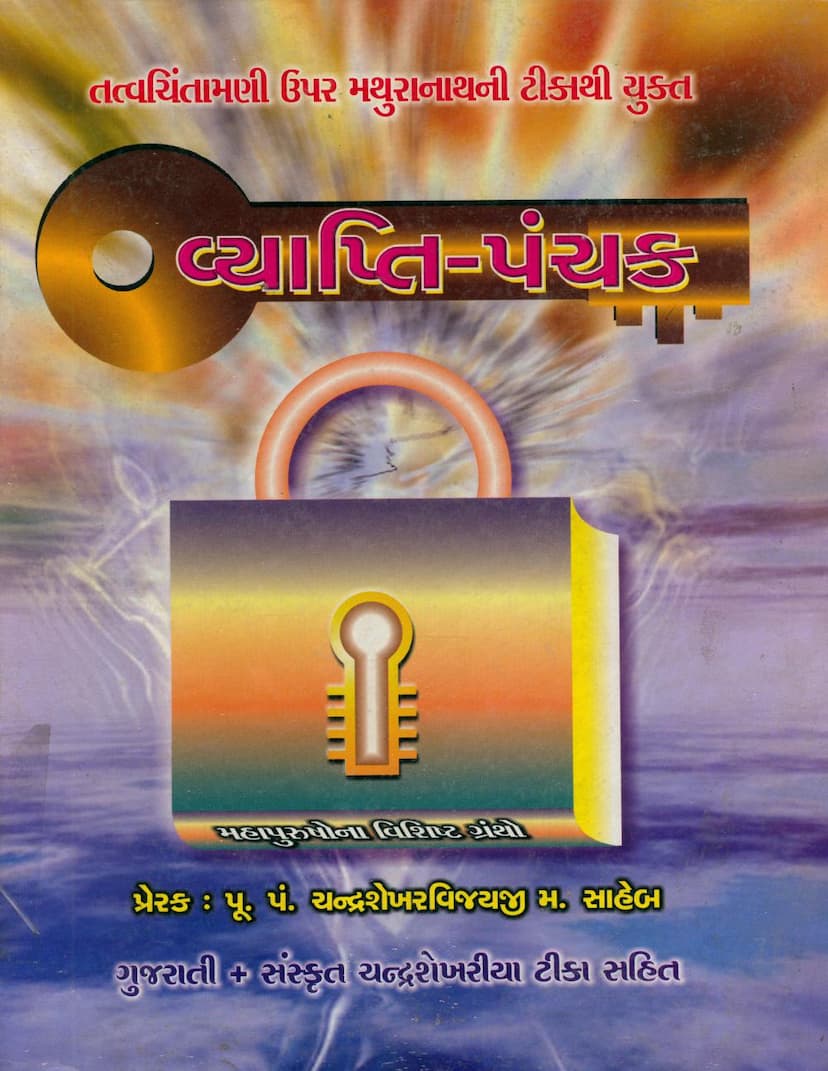Vyaptipanchak
Added to library: September 2, 2025

Summary
Here's a comprehensive summary of the Jain text "Vyaptipanchak" by Chandrashekharvijay, based on the provided pages:
Book Title: Vyaptipanchak Author: Chandrashekharvijay Publisher: Kamal Prakashan Trust Catalog Link: https://jainqq.org/explore/032160/1
Core Purpose and Introduction (Page 5-8):
The preface of "Vyaptipanchak" highlights the importance of sharp intellect (pragna) for understanding profound Jain scriptures. Just as a dull knife needs a sharpener to become useful for preparing food and benefiting others, the intellect needs to be sharpened by studying "Nyaya" (logic) texts. The author emphasizes that Nyaya texts are intricate, with subtle meanings and profound discussions on each word, requiring intense concentration from both students and teachers. It is stated that finding capable teachers for Nyaya texts is rare, especially for introductory texts like "Vyaptipanchaka."
The text aims to make the study of "Vyaptipanchak," a highly difficult text, more accessible through a simple commentary in both Sanskrit and Gujarati. This is intended to provide a "sharpening stone" for the intellect, enabling Jain ascetics (sanyamis) to delve deeper into Jinagamas (Jain scriptures) and the works of great scholars like Haribhadra Suri and Yashovijayji. The ultimate goal is to revitalise the path to liberation, making it more vibrant and accessible to more souls.
Key Aspects and Content:
- The Nature of Nyaya Texts: Nyaya texts are described as rigorous, requiring deep intellectual engagement. They are crucial for extracting profound meanings and secrets from Jain scriptures.
- The Commentary: The book provides a "Chandrashekharia" commentary, which is a simplified explanation in both Sanskrit and Gujarati, on Mathuranath's "Mathuri" commentary. This commentary aims to make the complex philosophical concepts easier to grasp.
- Target Audience: While acknowledging the difficulty, the book is primarily aimed at Jain ascetics who seek a deeper understanding of logic and its application to Jain philosophy. The author suggests that ascetics with moderate intellectual capacity should study at least up to "Vyaptipanchak" and "Siddhanta Lakshana" to properly understand the works of great Mahatmas.
- The Importance of Practice: The preface strongly advises students to write down what they learn and revise it, emphasizing the importance of this practice for solidifying understanding.
- "Vyaptipanchak" Itself: The original "Vyaptipanchak" text is described as a short work of only five to six lines, which are actually verses from "Tattvachintamani." The commentary by Mathuranath and Jagdishji forms the substantial part of what is considered "Vyaptipanchak" in this context. This particular edition focuses on Mathuranath's "Mathuri" commentary.
- The Role of Logic in Jainism: The preface draws a parallel between logic and a sharpening stone, highlighting its instrumental role in refining the intellect for higher spiritual pursuits. It cautions against getting lost in the study of logic itself, emphasizing that the ultimate goal is to apply this sharpened intellect to the scriptures for spiritual progress and liberation.
- The Current State of Study: The text notes that many ascetics are now able to study previously daunting texts due to the availability of translations and commentaries, indicating a revival of interest in deeper philosophical study.
- Influence of Non-Jain Nyaya: The preface suggests that a deep study of non-Jain Nyaya texts has been foundational for many individuals who later contributed significantly to Jain scholarship, likening this foundational study to the roots of a flourishing Kalpavriksha (wish-fulfilling tree).
- Structure of the Commentary (Page 10 onwards): The commentary begins by analyzing the introductory verse of Tattvachintamani, which poses a question about "vyapti" (pervasion). It delves into the concept of "Upaodghata Sangati" (introductory connection) and presents different interpretations from Mathuri's commentary. The commentary meticulously breaks down the philosophical arguments, explains the etymology of terms, and addresses potential issues like overextension (ativyapti) and non-pervasion (avyapti) in the definitions of "vyapti."
Detailed Analysis of "Vyapti" Definitions (Pages 10-41):
The commentary meticulously dissects the five definitions of "vyapti" (pervasion) presented in Nyaya literature, critically examining each one:
- "Sādhyābhāvadvad-avṛttitvam" (Non-location in the absence of the predicate): This is the first definition explored. The commentary discusses its grammatical derivation, analyzes its logical implications, and refutes criticisms like "ativyapti" (overextension) and "avyapti" (non-pervasion). It addresses complex issues of the locus of absence and the role of different types of conjunctions.
- "Sādhyavadbhinn-asādhyāvad-avṛttitvam" (Non-location in the absence of the predicate, which is different from the locus of the probandum): This definition is presented as an alternative to the first, aiming to avoid certain logical pitfalls. The commentary explores its grammatical structure and debates its validity.
- "Sādhyavpratiyogik-bheda-asamānādhikaraṇatvam" (Non-co-location with the different from the probandum-holder): This definition is analyzed for its logical soundness and potential for fallacies. The commentary discusses the nuances of "difference" and "co-location."
- "Sakala-sādhyābhāvadvat-niṣṭhābhāva-pratiyogitvam" (The counter-positive of the absence existing in all loci of the absence of the probandum): This definition is presented as a key component in establishing the correct understanding of "vyapti." It focuses on the pervasive nature of the absence of the probandum.
- "Sādhyavad-anyavṛttitvam" (Non-location in the absence of the probandum which is different from the locus of the probandum): This is the fifth and final definition discussed, with detailed analysis of its grammatical structure and logical implications.
Throughout the analysis of these definitions, the commentary engages with various interpretations, potential logical fallacies (like "ativyapti" and "avyapti"), and the proper grammatical and philosophical meanings of the terms used. The text emphasizes the need for precise understanding to avoid errors in logical reasoning.
Concluding Remarks:
The commentary concludes by stating that the five definitions of "vyapti" have been thoroughly discussed. It reiterates that the true definition of "vyapti" is to be found in the "Siddhanta Lakshana," a subsequent text. The "Vyaptipanchak" is presented as a foundational step in the rigorous study of Nyaya for ascetics, enabling them to progress to more advanced philosophical texts. The work is dedicated to the author's guru, Pt. Chandrashekharvijayji, and aims to benefit the Jain community by promoting deeper scriptural understanding.